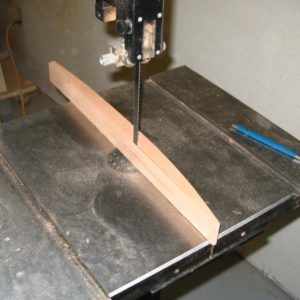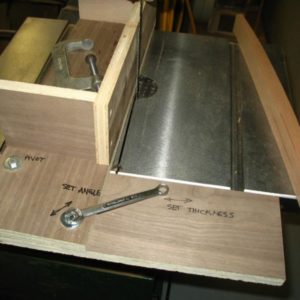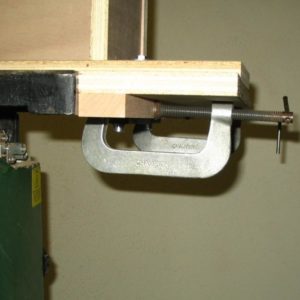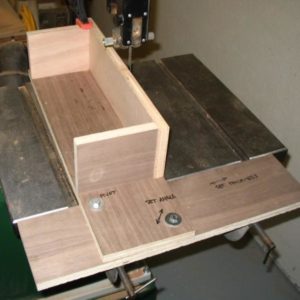I just purchased a Rikon 14″ deluxe bandsaw and have already put it to work resawing laminations for a bent lamination chair apron. I do not like the Rikon rip fence. So, I designed a resaw fence that worked very well so far. It takes advantage of a machined surface on the front edge of the top casting. It is, very simply, an adjustable T-square. The photos show the details.
The process is as follows:
1. Establish the drift angle. Draw a line parallel to the edge of a board, about 1/8″ from the edge. Saw down the line until you are comfortable that the drift angle is consistent. Without moving the board, draw a line on the top along the edge of the board with a pencil.
2. Place the jig against the front edge of the top. Adjust the angle to match the pencil line.
3. Move the jig left to right to set thickness. Clamp at front rail. I added a clamp at the rear also, as insurance against bumping the fence.
The designed allows you to independently adjust angle and thickness, which really simplifies set up. So far, the angle has remained constant, so I can change thicknesses easily without affecting the angle setting.
Best regards, Tom.


















Replies
Very nicely done. That's a clever solution.
Frosty
"I sometimes think we consider the good fortune of the early bird and overlook the bad fortune of the early worm." FDR - 1922
Thanks, Frosty,
I have run over one hundred pieces through the saw using this fence in the last two days. I am wearing out, but the fence is working well.Tom.
I've re-sawed (re-sawn?) lams. It does get tedious. But the glue-up is anything but boring.Frosty"I sometimes think we consider the good fortune of the early bird and overlook the bad fortune of the early worm." FDR - 1922
Frosty,
We haven't talked in a while. Take a look at my latest creations in post number 2714 (as I remember) in the long thread in Hand Tools, named "Jointer plane question? Lie-Nielsen). I have been carving some large bowls, and a few of them turned out better than I had hoped.
Thanks,
MelMeasure your output in smiles per board foot.
Mel,I was out of town last week at a Finishing class at MASW. Sorry to be late getting back to you.I tried post 2714 but 'struck out'. I think it should have been 5 digits long. I did look up your "bowl posts" but didn't pics of your work. Some of the others were outstanding. I have been working on an oval, see-through, glass topped table mounted on an oval base. Really quite challenging on several different levels: plunging an ellipse through 8/4 cherry at four different "radii; working on the joinery at the juncture of curved, variably shaped legs to the bottom ellipse. I would grade my first effort a "C". I'm sure the next effort will be an "A". I'm always an optimist at the beginning of a project.Frosty"I sometimes think we consider the good fortune of the early bird and overlook the bad fortune of the early worm." FDR - 1922
Frosty,
Just got back from a wedding in Connecticut (my niece's). Saw your message. I hope you post a photo or two of your oval glass-topped table. It sounds quite challenging.The number that I gave you to find my post with photos of my bowls was the number of the post in that thread. Now I see that the best way to give a reference to a particular post is by its special number. SO, the post with the photos of my bowls is
37729.2714Thanks for writing.
MelMeasure your output in smiles per board foot.
That's better. Now I found it. They are beautiful, Mel. I can see why it has become "an obsession". The freedom from tape-measures, story sticks and combination squares must be glorious. Your choice of designs must be motivated by the grain patterns you uncover. Keep up the good work!P.S. I'm sure I would never have found it. Post #2700 on a L-N category. Who would have thoughtFrosty"I sometimes think we consider the good fortune of the early bird and overlook the bad fortune of the early worm." FDR - 1922
Frosty,"Your choice of designs must be motivated by the grain patterns you uncover. "Yup. yuk yuk. I took a cue from Nakashima. I talk to the wood, and I listen to it. Sometimes it tells me what to do. Just looking at the grain sometimes makes obvious what will look good.Thanks for the nice words about my bowls.That long thread has been a hoot. It has had nothing to do with Lie Nielsen for a long long time. The topics just keep changing. People come and comment and go. Some stay. There has been no nastiness. It is more like a "chat room". It has been fun. Stop over every once in a while to see what is happening, and join in, if you feel like it.Have fun.
MelMeasure your output in smiles per board foot.
Tom,
Thanks for your post. I spent most of yesterday resawing with a resaw block and didn't have much success. I think I'll build myself a fence like yours! Are there any improvements you'd make after using it for a day? I don't think I'll use walnut ply, though.
Chris @ flairwoodworks
- Success is not the key to happines. Happiness is the key to success. If you love what you are doing, you will be successful. - Albert Schweitzer
Chris,I am still happy with the fence. I think clamping at both front and rear is necessary, not just helpful. I push pretty hard at times to keep the stock firmly against the fence. The other issue that I have experienced is squareness of the table top. It seems to move periodically, causing me to create tapered laminates. When adjusted square, I was getting laminates 52" long, 3" wide, and .075" thick with total variation of about .006". Later, I realized there was a problem because there was a taper of more than .010" across the 3" width. I watch that carefully now.By the way, I used 1/4-20 bolts with t-nuts in the bottom rail. The front rail is about 20" by 5". The fence base is about 21" by 6". Fence height is about 5" overall. Squareness of the fence to the base is almost perfect.Let me know your experiences.Best regards, Tom.
This forum post is now archived. Commenting has been disabled